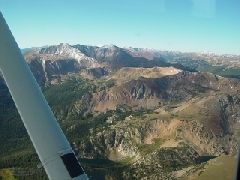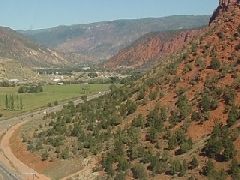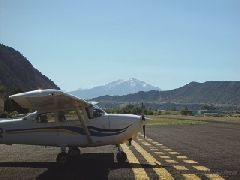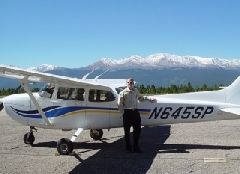Flying the Colorado Rockies
By Jeff Snyder 1
I recently had the opportunity to travel to Colorado to visit family and while there to meet up with Mark for some mountain flying.

To sum things up, the flight was wonderful! We could not have picked a more perfect day to fly. It wasn’t until the last leg of the flight that any real noticeable number of clouds started to appear.
The flight took us from Centennial Airport in Denver (KAPA) over Jeffco (KBJC) and due west over Rollins (Corona) Pass. Rollins Pass is at 11,671′ MSL, which required us to climb to about 13,000′ MSL. We were flying a 180 HP 172SP. Not a lot of power, but enough. From what Mark told me, it was more important to have a plane that I was comfortable with than to throw in another unknown. In retrospect, the 172SP performed much better than I expected at those altitudes.
 After passing Rollins pass, we headed over to Kremmling CO (20V), landed, reported our arrival to Flight Service, reorganized the cockpit for the next leg, and were off again. This time, we basically followed the Colorado River down to Glenwood Springs (KGWS). Glenwood Springs is an interesting airport. It lies in a canyon, which required us to descend into the canyon while making our downwind-to-base turn and then fly the final approach without being able to see the runway (due to a large rock outcropping).
After passing Rollins pass, we headed over to Kremmling CO (20V), landed, reported our arrival to Flight Service, reorganized the cockpit for the next leg, and were off again. This time, we basically followed the Colorado River down to Glenwood Springs (KGWS). Glenwood Springs is an interesting airport. It lies in a canyon, which required us to descend into the canyon while making our downwind-to-base turn and then fly the final approach without being able to see the runway (due to a large rock outcropping).
Departing Glenwood Springs, we “hugged” the canyon wall and flew the same ground track as the approach. Needless to say, we were diligently watching for traffic! We then proceeded over to Aspen (KASE), which required us to contact Approach Control and fly another “blind” approach. We were not able to see the runway until we turned final 1200 feet above the runway. Although it was not as “tight” as the GWS approach, it sure was fun to land at ….ASPEN!
A quick call to give a progress report to our friend, Wes, and we headed out of Aspen, followed a ridge line west while gaining altitude to cross it before turning east toward Reudi Reservoir and beginning our climb to Hagerman Pass. Hagerman Pass rises to 12,300′ MSL, which required us to climb quite a bit over 13,000′ MSL to cross it safely. Incredibly, updrafts on the windward side of the pass helped us maintain a 600 FPM climb, even at those altitudes.

We finally landed at Leadville (KLXV) – the highest airport in North America at 9,927’msl. We met up with Wes for lunch. After having traversed Hagerman to get to Leadville and dealt with its altitude for landing and takeoff, I have to tip my hat to Wes for choosing that airport to do his own private pilot training!! Once he gets his license there, this whole density altitude thing will be a snap. Then he’ll have to contend with all that excess power when he comes down to the lowlands.
Anyway, once we finally took off from Leadville, it was a pretty simple matter of just climbing to a bit over pattern altitude and maintaining that all the way back to Denver. Pretty much downhill all the way!
All in all, it was a great time and a great experience.
1. Story and photographs copyright ©2003 Jeffrey Snyder. All Rights Reserved. Return to story.